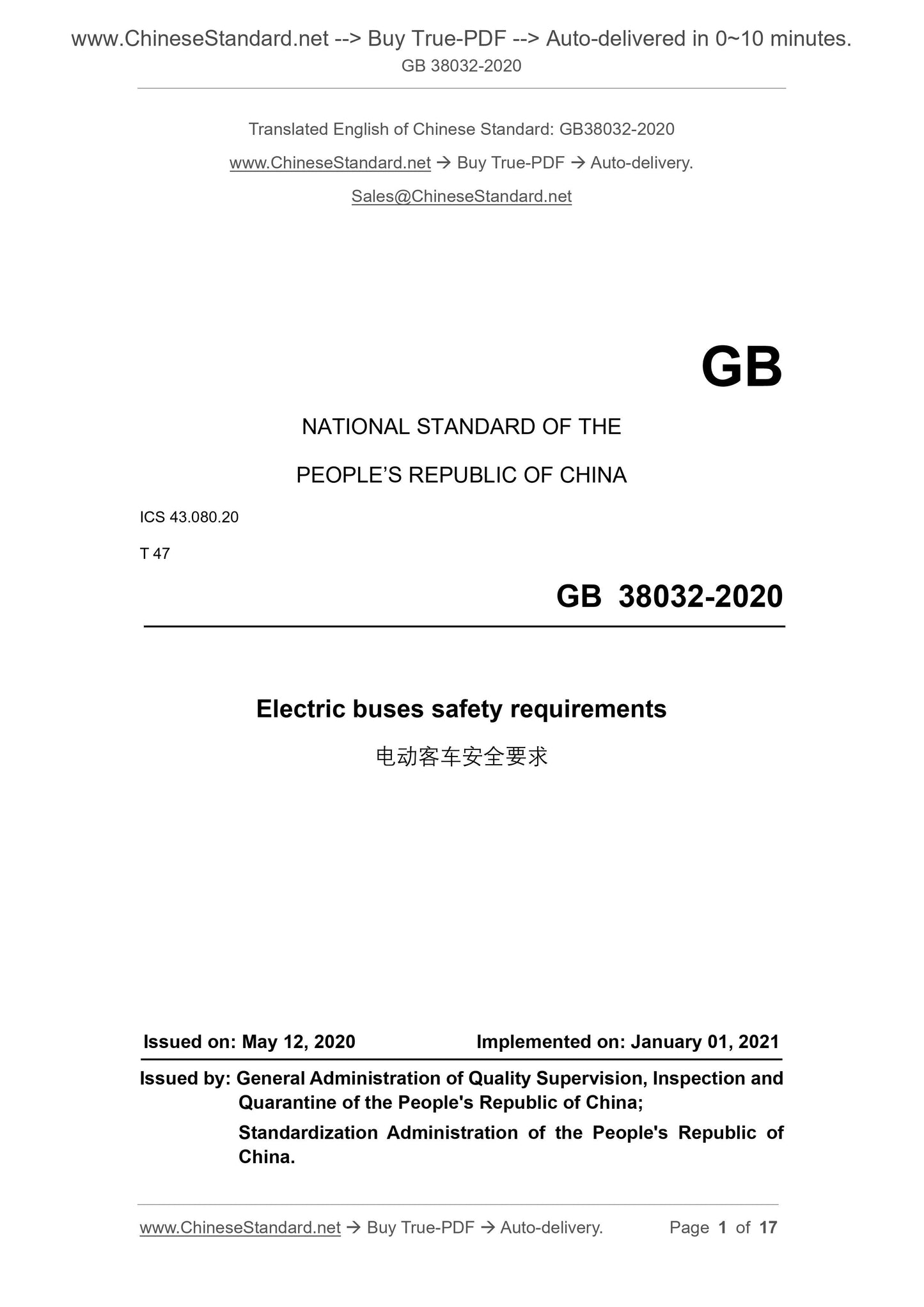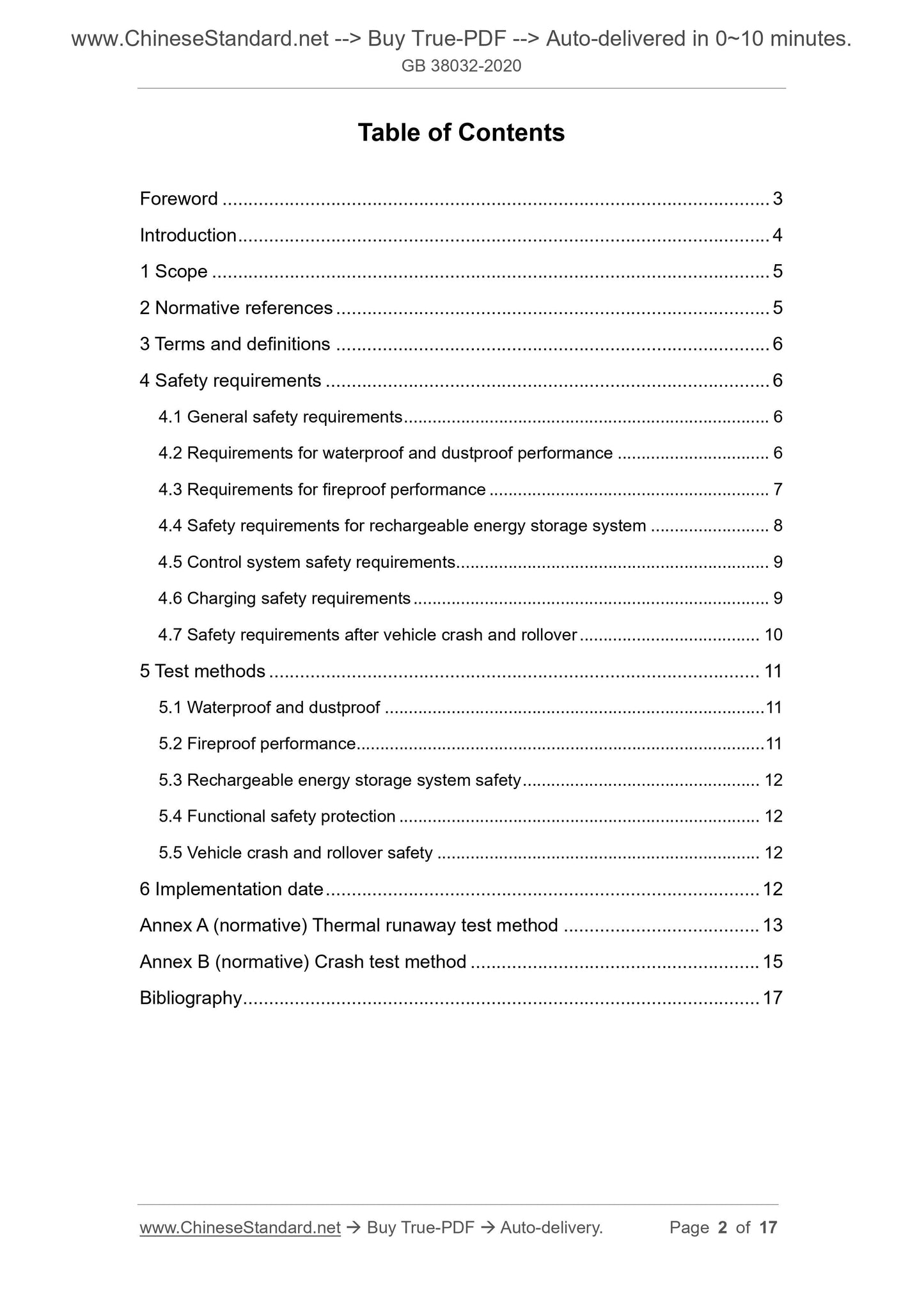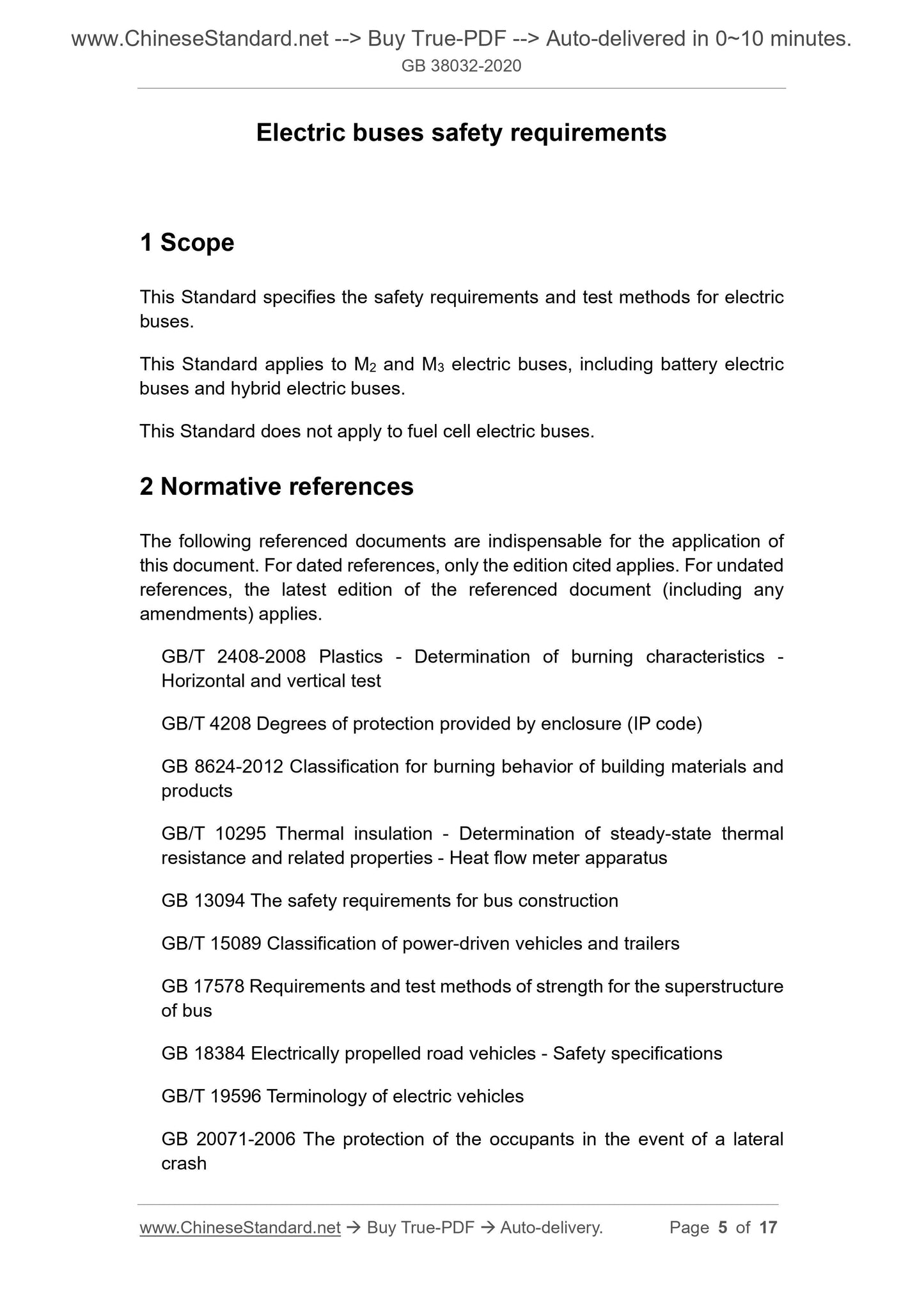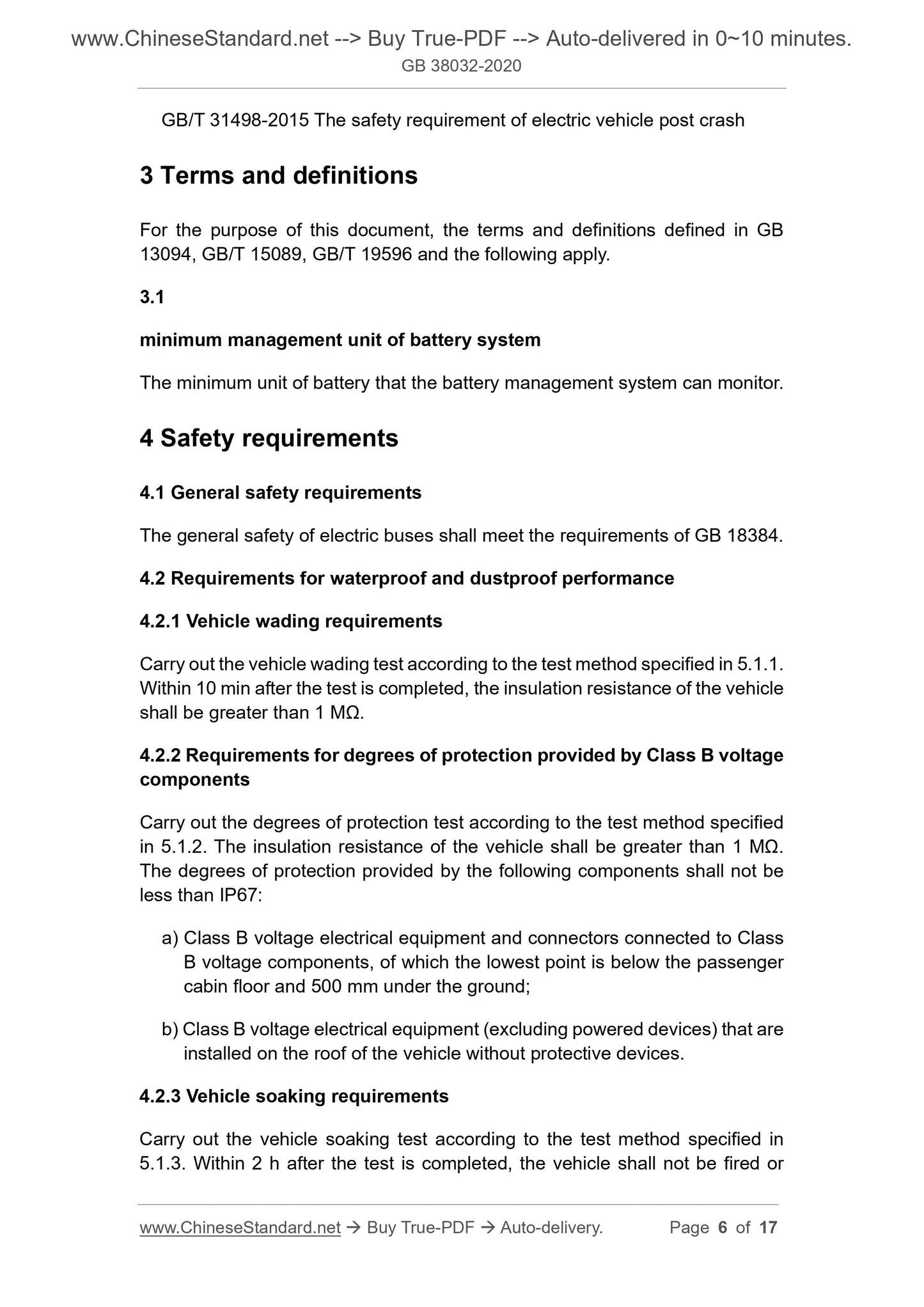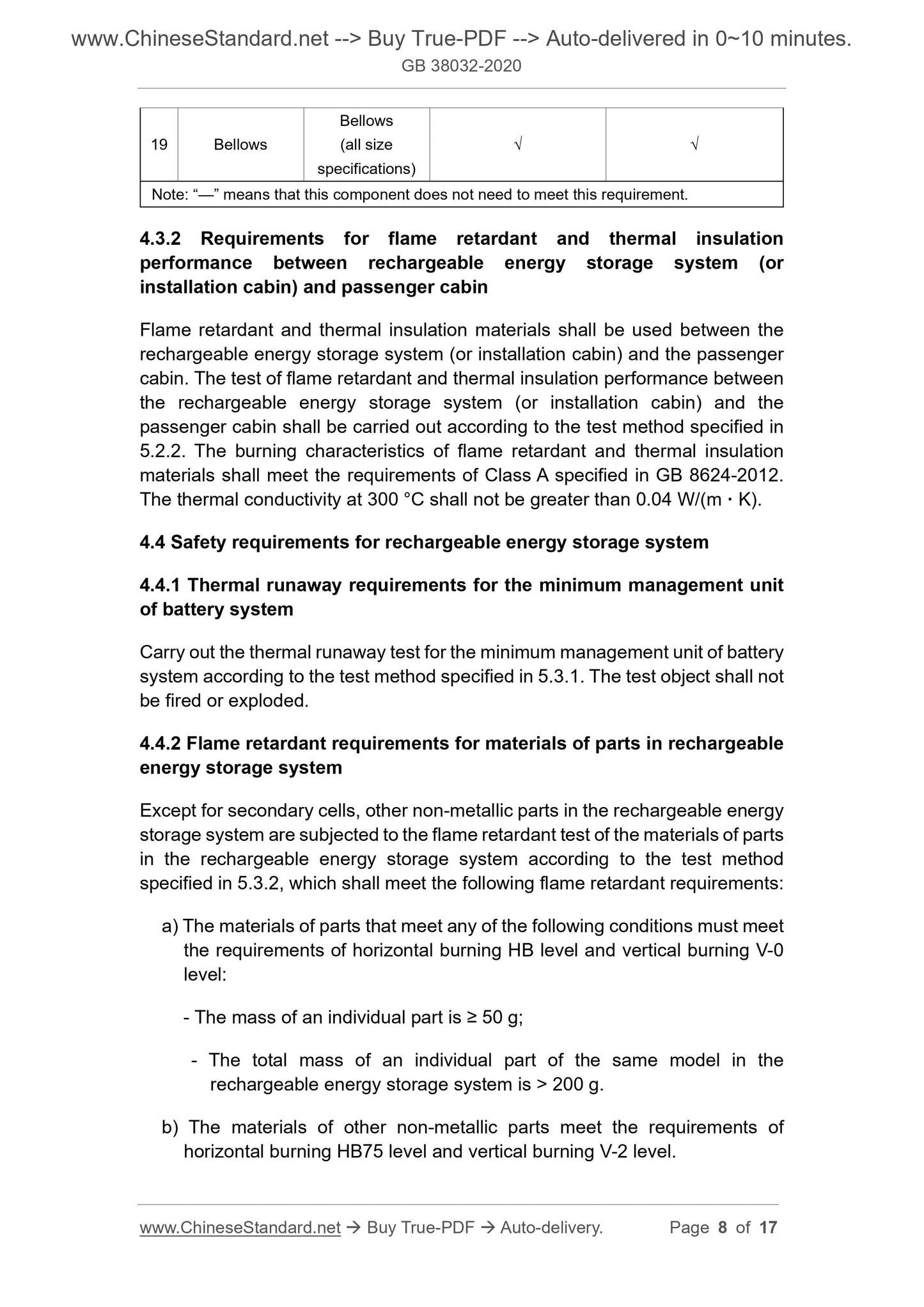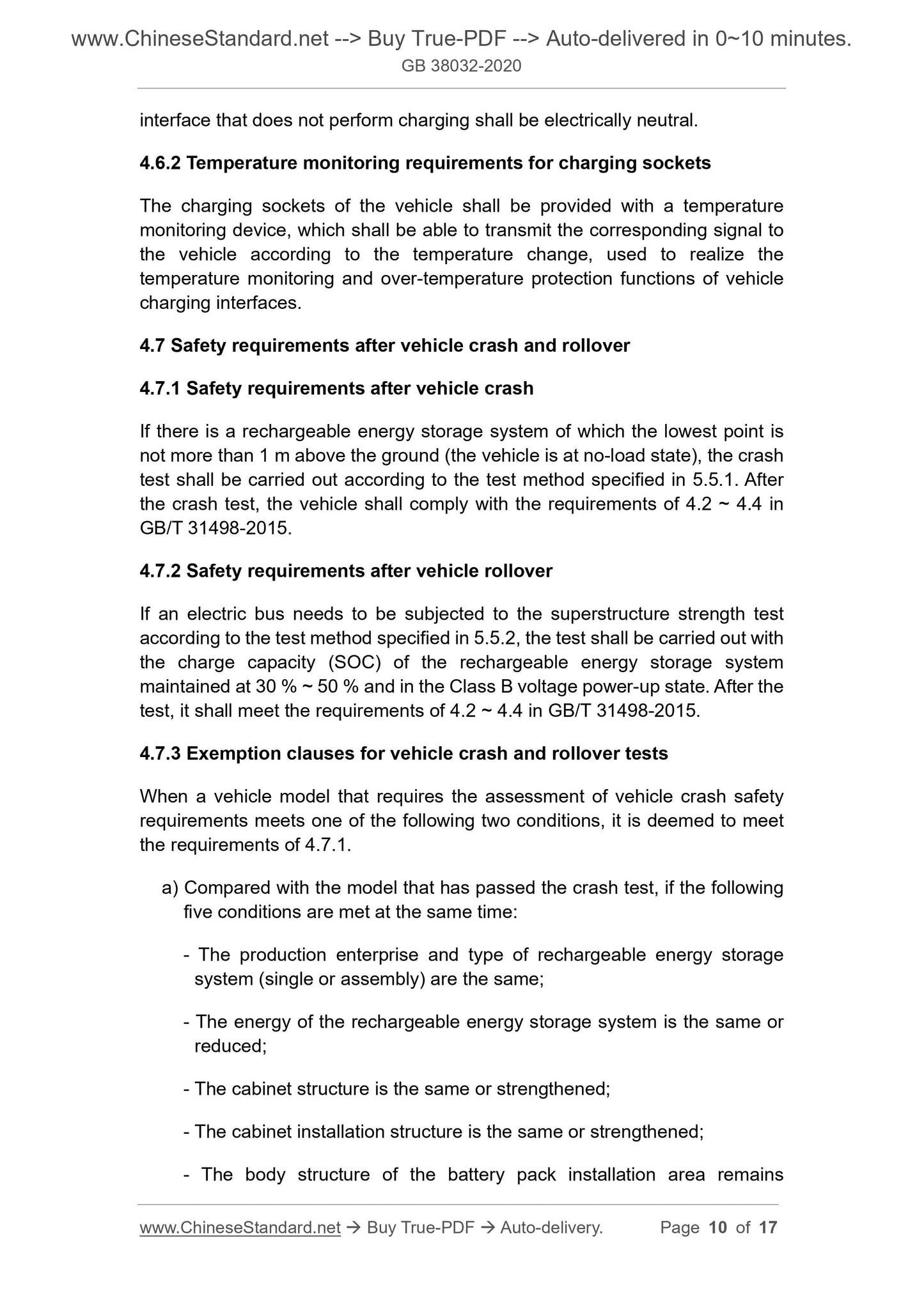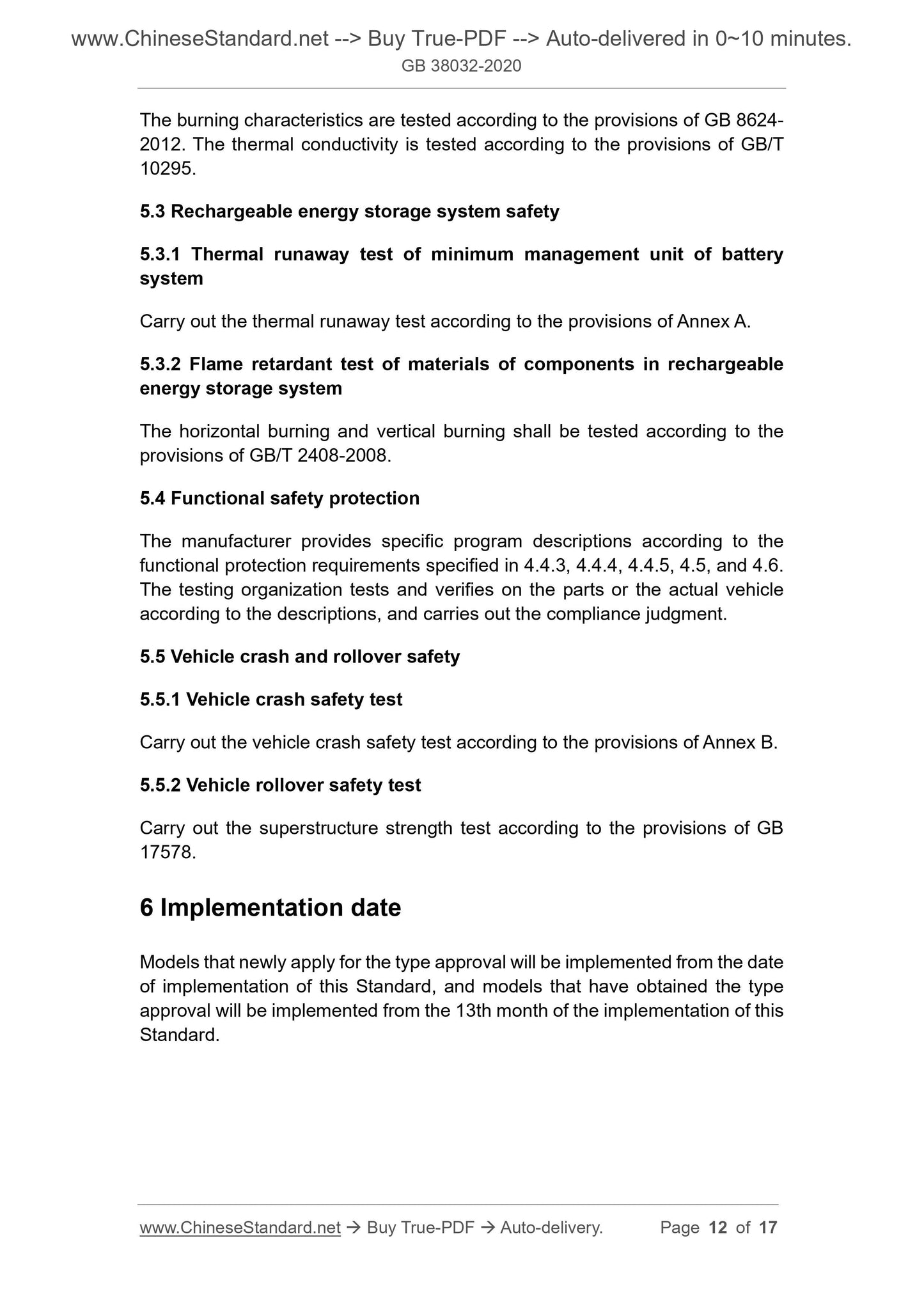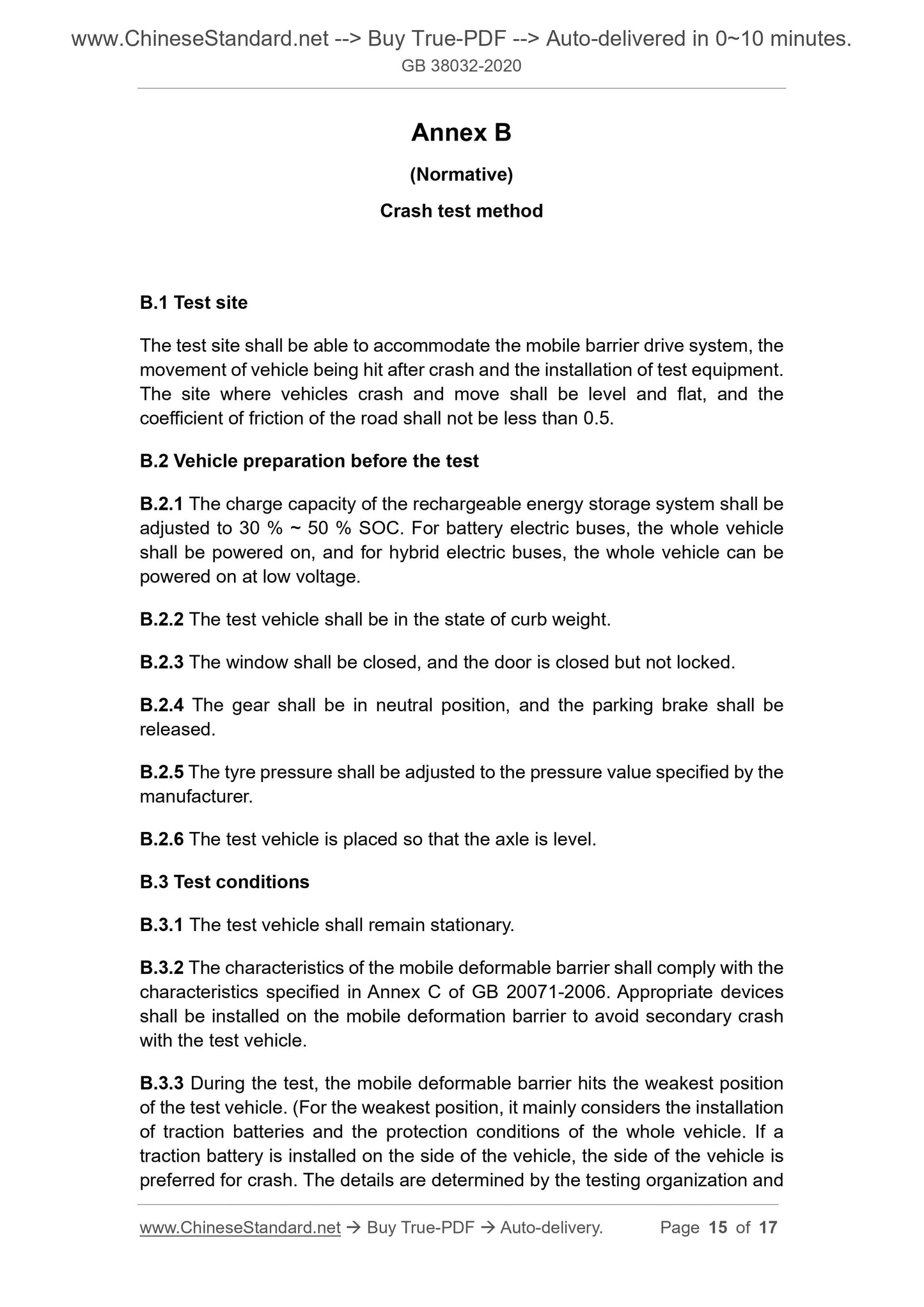1
/
su
8
PayPal, credit cards. Download editable-PDF & invoice in 1 second!
GB 38032-2020 English PDF (GB38032-2020)
GB 38032-2020 English PDF (GB38032-2020)
Prezzo di listino
$145.00 USD
Prezzo di listino
Prezzo scontato
$145.00 USD
Prezzo unitario
/
per
Spese di spedizione calcolate al check-out.
Impossibile caricare la disponibilità di ritiro
Delivery: 3 seconds. Download true-PDF + Invoice.
Get QUOTATION in 1-minute: Click GB 38032-2020
Historical versions: GB 38032-2020
Preview True-PDF (Reload/Scroll if blank)
GB 38032-2020: Electric buses safety requirements
GB 38032-2020
NATIONAL STANDARD OF THE
PEOPLE’S REPUBLIC OF CHINA
ICS 43.080.20
T 47
Electric buses safety requirements
ISSUED ON: MAY 12, 2020
IMPLEMENTED ON: JANUARY 01, 2021
Issued by: General Administration of Quality Supervision, Inspection and
Quarantine of the People's Republic of China;
Standardization Administration of the People's Republic of
China.
Table of Contents
Foreword ... 3
Introduction ... 4
1 Scope ... 5
2 Normative references ... 5
3 Terms and definitions ... 6
4 Safety requirements ... 6
4.1 General safety requirements ... 6
4.2 Requirements for waterproof and dustproof performance ... 6
4.3 Requirements for fireproof performance ... 7
4.4 Safety requirements for rechargeable energy storage system ... 8
4.5 Control system safety requirements ... 9
4.6 Charging safety requirements ... 9
4.7 Safety requirements after vehicle crash and rollover ... 10
5 Test methods ... 11
5.1 Waterproof and dustproof ... 11
5.2 Fireproof performance ... 11
5.3 Rechargeable energy storage system safety ... 12
5.4 Functional safety protection ... 12
5.5 Vehicle crash and rollover safety ... 12
6 Implementation date ... 12
Annex A (normative) Thermal runaway test method ... 13
Annex B (normative) Crash test method ... 15
Bibliography ... 17
Electric buses safety requirements
1 Scope
This Standard specifies the safety requirements and test methods for electric
buses.
This Standard applies to M2 and M3 electric buses, including battery electric
buses and hybrid electric buses.
This Standard does not apply to fuel cell electric buses.
2 Normative references
The following referenced documents are indispensable for the application of
this document. For dated references, only the edition cited applies. For undated
references, the latest edition of the referenced document (including any
amendments) applies.
GB/T 2408-2008 Plastics - Determination of burning characteristics -
Horizontal and vertical test
GB/T 4208 Degrees of protection provided by enclosure (IP code)
GB 8624-2012 Classification for burning behavior of building materials and
products
GB/T 10295 Thermal insulation - Determination of steady-state thermal
resistance and related properties - Heat flow meter apparatus
GB 13094 The safety requirements for bus construction
GB/T 15089 Classification of power-driven vehicles and trailers
GB 17578 Requirements and test methods of strength for the superstructure
of bus
GB 18384 Electrically propelled road vehicles - Safety specifications
GB/T 19596 Terminology of electric vehicles
GB 20071-2006 The protection of the occupants in the event of a lateral
crash
GB/T 31498-2015 The safety requirement of electric vehicle post crash
3 Terms and definitions
For the purpose of this document, the terms and definitions defined in GB
13094, GB/T 15089, GB/T 19596 and the following apply.
3.1
minimum management unit of battery system
The minimum unit of battery that the battery management system can monitor.
4 Safety requirements
4.1 General safety requirements
The general safety of electric buses shall meet the requirements of GB 18384.
4.2 Requirements for waterproof and dustproof performance
4.2.1 Vehicle wading requirements
Carry out the vehicle wading test according to the test method specified in 5.1.1.
Within 10 min after the test is completed, the insulation resistance of the vehicle
shall be greater than 1 MΩ.
4.2.2 Requirements for degrees of protection provided by Class B voltage
components
Carry out the degrees of protection test according to the test method specified
in 5.1.2. The insulation resistance of the vehicle shall be greater than 1 MΩ.
The degrees of protection provided by the following components shall not be
less than IP67:
a) Class B voltage electrical equipment and connectors connected to Class
B voltage components, of which the lowest point is below the passenger
cabin floor and 500 mm under the ground;
b) Class B voltage electrical equipment (excluding powered devices) that are
installed on the roof of the vehicle without protective devices.
4.2.3 Vehicle soaking requirements
Carry out the vehicle soaking test according to the test method specified in
5.1.3. Within 2 h after the test is completed, the vehicle shall not be fired or
19 Bellows
Bellows
(all size
specifications)
√ √
Note: “—” means that this component does not need to meet this requirement.
4.3.2 Requirements for flame retardant and thermal insulation
performance between rechargeable energy storage system (or
installation cabin) and passenger cabin
Flame retardant and thermal insulation materials shall be used between the
rechargeable energy storage system (or installation cabin) and the passenger
cabin. The test of flame retardant and thermal insulation performance between
the rechargeable energy storage system (or installation cabin) and the
passenger cabin shall be carried out according to the test method specified in
5.2.2. The burning characteristics of flame retardant and thermal insulation
materials shall meet the requirements of Class A specified in GB 8624-2012.
The thermal conductivity at 300 °C shall not be greater than 0.04 W/(m · K).
4.4 Safety requirements for rechargeable energy storage system
4.4.1 Thermal runaway requirements for the minimum management unit
of battery system
Carry out the thermal runaway test for the minimum management unit of battery
system according to the test method specified in 5.3.1. The test object shall not
be fired or exploded.
4.4.2 Flame retardant requirements for materials of parts in rechargeable
energy storage system
Except for secondary cells, other non-metallic parts in the rechargeable energy
storage system are subjected to the flame retardant test of the materials of parts
in the rechargeable energy storage system according to the test method
specified in 5.3.2, which shall meet the following flame retardant requirements:
a) The materials of parts that meet any of the following conditions must meet
the requirements of horizontal burning HB level and vertical burning V-0
level:
- The mass of an individual part is ≥ 50 g;
- The total mass of an individual part of the same model in the
rechargeable energy storage system is > 200 g.
b) The materials of other non-metallic parts meet the requirements of
horizontal burning HB75 level and vertical burning V-2 level.
interface that does not perform charging shall be electrically neutral.
4.6.2 Temperature monitoring requirements for charging sockets
The charging sockets of the vehicle shall be provided with a temperature
monitoring device, which shall be able to transmit the corresponding signal to
the vehicle according to the temperature change, used to realize the
temperature monitoring and over-temperature protection functions of vehicle
charging interfaces.
4.7 Safety requirements after vehicle crash and rollover
4.7.1 Safety requirements after vehicle crash
If there is a rechargeable energy storage system of which the lowest point is
not more than 1 m above the ground (the vehicle is at no-load state), the crash
test shall be carried out according to the test method specified in 5.5.1. After
the crash test, the vehicle shall comply with the requirements of 4.2 ~ 4.4 in
GB/T 31498-2015.
4.7.2 Safety requirements after vehicle rollover
If an electric bus needs to be subjec...
Get QUOTATION in 1-minute: Click GB 38032-2020
Historical versions: GB 38032-2020
Preview True-PDF (Reload/Scroll if blank)
GB 38032-2020: Electric buses safety requirements
GB 38032-2020
NATIONAL STANDARD OF THE
PEOPLE’S REPUBLIC OF CHINA
ICS 43.080.20
T 47
Electric buses safety requirements
ISSUED ON: MAY 12, 2020
IMPLEMENTED ON: JANUARY 01, 2021
Issued by: General Administration of Quality Supervision, Inspection and
Quarantine of the People's Republic of China;
Standardization Administration of the People's Republic of
China.
Table of Contents
Foreword ... 3
Introduction ... 4
1 Scope ... 5
2 Normative references ... 5
3 Terms and definitions ... 6
4 Safety requirements ... 6
4.1 General safety requirements ... 6
4.2 Requirements for waterproof and dustproof performance ... 6
4.3 Requirements for fireproof performance ... 7
4.4 Safety requirements for rechargeable energy storage system ... 8
4.5 Control system safety requirements ... 9
4.6 Charging safety requirements ... 9
4.7 Safety requirements after vehicle crash and rollover ... 10
5 Test methods ... 11
5.1 Waterproof and dustproof ... 11
5.2 Fireproof performance ... 11
5.3 Rechargeable energy storage system safety ... 12
5.4 Functional safety protection ... 12
5.5 Vehicle crash and rollover safety ... 12
6 Implementation date ... 12
Annex A (normative) Thermal runaway test method ... 13
Annex B (normative) Crash test method ... 15
Bibliography ... 17
Electric buses safety requirements
1 Scope
This Standard specifies the safety requirements and test methods for electric
buses.
This Standard applies to M2 and M3 electric buses, including battery electric
buses and hybrid electric buses.
This Standard does not apply to fuel cell electric buses.
2 Normative references
The following referenced documents are indispensable for the application of
this document. For dated references, only the edition cited applies. For undated
references, the latest edition of the referenced document (including any
amendments) applies.
GB/T 2408-2008 Plastics - Determination of burning characteristics -
Horizontal and vertical test
GB/T 4208 Degrees of protection provided by enclosure (IP code)
GB 8624-2012 Classification for burning behavior of building materials and
products
GB/T 10295 Thermal insulation - Determination of steady-state thermal
resistance and related properties - Heat flow meter apparatus
GB 13094 The safety requirements for bus construction
GB/T 15089 Classification of power-driven vehicles and trailers
GB 17578 Requirements and test methods of strength for the superstructure
of bus
GB 18384 Electrically propelled road vehicles - Safety specifications
GB/T 19596 Terminology of electric vehicles
GB 20071-2006 The protection of the occupants in the event of a lateral
crash
GB/T 31498-2015 The safety requirement of electric vehicle post crash
3 Terms and definitions
For the purpose of this document, the terms and definitions defined in GB
13094, GB/T 15089, GB/T 19596 and the following apply.
3.1
minimum management unit of battery system
The minimum unit of battery that the battery management system can monitor.
4 Safety requirements
4.1 General safety requirements
The general safety of electric buses shall meet the requirements of GB 18384.
4.2 Requirements for waterproof and dustproof performance
4.2.1 Vehicle wading requirements
Carry out the vehicle wading test according to the test method specified in 5.1.1.
Within 10 min after the test is completed, the insulation resistance of the vehicle
shall be greater than 1 MΩ.
4.2.2 Requirements for degrees of protection provided by Class B voltage
components
Carry out the degrees of protection test according to the test method specified
in 5.1.2. The insulation resistance of the vehicle shall be greater than 1 MΩ.
The degrees of protection provided by the following components shall not be
less than IP67:
a) Class B voltage electrical equipment and connectors connected to Class
B voltage components, of which the lowest point is below the passenger
cabin floor and 500 mm under the ground;
b) Class B voltage electrical equipment (excluding powered devices) that are
installed on the roof of the vehicle without protective devices.
4.2.3 Vehicle soaking requirements
Carry out the vehicle soaking test according to the test method specified in
5.1.3. Within 2 h after the test is completed, the vehicle shall not be fired or
19 Bellows
Bellows
(all size
specifications)
√ √
Note: “—” means that this component does not need to meet this requirement.
4.3.2 Requirements for flame retardant and thermal insulation
performance between rechargeable energy storage system (or
installation cabin) and passenger cabin
Flame retardant and thermal insulation materials shall be used between the
rechargeable energy storage system (or installation cabin) and the passenger
cabin. The test of flame retardant and thermal insulation performance between
the rechargeable energy storage system (or installation cabin) and the
passenger cabin shall be carried out according to the test method specified in
5.2.2. The burning characteristics of flame retardant and thermal insulation
materials shall meet the requirements of Class A specified in GB 8624-2012.
The thermal conductivity at 300 °C shall not be greater than 0.04 W/(m · K).
4.4 Safety requirements for rechargeable energy storage system
4.4.1 Thermal runaway requirements for the minimum management unit
of battery system
Carry out the thermal runaway test for the minimum management unit of battery
system according to the test method specified in 5.3.1. The test object shall not
be fired or exploded.
4.4.2 Flame retardant requirements for materials of parts in rechargeable
energy storage system
Except for secondary cells, other non-metallic parts in the rechargeable energy
storage system are subjected to the flame retardant test of the materials of parts
in the rechargeable energy storage system according to the test method
specified in 5.3.2, which shall meet the following flame retardant requirements:
a) The materials of parts that meet any of the following conditions must meet
the requirements of horizontal burning HB level and vertical burning V-0
level:
- The mass of an individual part is ≥ 50 g;
- The total mass of an individual part of the same model in the
rechargeable energy storage system is > 200 g.
b) The materials of other non-metallic parts meet the requirements of
horizontal burning HB75 level and vertical burning V-2 level.
interface that does not perform charging shall be electrically neutral.
4.6.2 Temperature monitoring requirements for charging sockets
The charging sockets of the vehicle shall be provided with a temperature
monitoring device, which shall be able to transmit the corresponding signal to
the vehicle according to the temperature change, used to realize the
temperature monitoring and over-temperature protection functions of vehicle
charging interfaces.
4.7 Safety requirements after vehicle crash and rollover
4.7.1 Safety requirements after vehicle crash
If there is a rechargeable energy storage system of which the lowest point is
not more than 1 m above the ground (the vehicle is at no-load state), the crash
test shall be carried out according to the test method specified in 5.5.1. After
the crash test, the vehicle shall comply with the requirements of 4.2 ~ 4.4 in
GB/T 31498-2015.
4.7.2 Safety requirements after vehicle rollover
If an electric bus needs to be subjec...
Share
